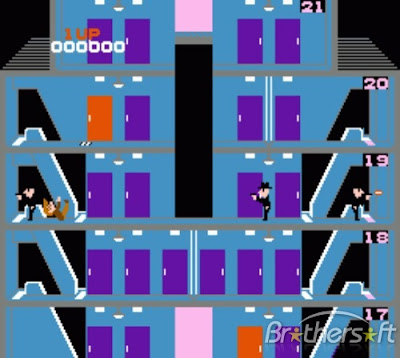 |
| Promo Poster. |
Continuing with great arcade classic, it felt almost mandatory, to look into the next arcade gem created by Taito in the early eighties. Elevator Action (エレベーターアクション Erebētā Akushon) is a 1983 arcade game. It debuted during what is now known as the "Golden Age of Arcade Games" (1981-1987).
Innovative in gameplay, this game was very popular for many years, with
game music created by musician Yoshino Imamura. The game was followed
by a cool sequel, Elevator Action II (also known as Elevator Action Returns). A shame we can't play it on the iPad/iPhone yet.
What is Elevator Action About?
The player assumes the role of a spy who infiltrates a building filled with elevators.
He must collect secret documents from the building and traverse the 30
levels of the building using an increasingly complex series of
elevators. The player is pursued by enemy agents who appear from behind
closed doors. The player must outwit them via force or evasion.
Successful completion of a level involves collecting all the secret
documents and traversing the building from top to bottom. In the lower
floors of the building, the elevator systems are so complex that some
puzzle-solving skills are needed.
The game cabinet is a standard upright. The controls consisted of a 4-way joystick
and two buttons, one for "shoot" and the other for jumping and kicking.
The graphics are extremely simple, 2D color graphics. The maximum
number of players is two, alternating turns.
 |
| Graphics didn't matter as long as you had enough fun playing games. |
Elevator Action Classic Gameplay
The player assumes the role of Agent 17, codename: "Otto", a secret
agent for an unspecified organization or government. As Otto, the player
must "acquire" (steal) a series of secret documents from a tall
building which Otto enters from the roof. Each room with a document is
indicated by a red door. Otto must traverse the building's numerous
levels via a series of elevators and escalators
while acquiring the documents. After retrieving all the documents, Otto
must escape via the getaway car in the basement of the building and
thus progress to the next level of the game. Otto's mobility consists of
movement left or right, jumping, and dropping to a knee, however,
dropping to a knee is not possible while in control of an elevator due
to the need to control the elevator's up and down movement. At the
escalators near the middle of the building, up and down naturally
commands Otto to go up or down the escalators.
In order to defend against the enemy agents, Otto can either shoot
them, with a maximum of three rounds per volley, or if close enough jump
towards them and make contact as in kicking them. When defeated, enemy
agents will collapse and then disappear. It is also possible to avoid
enemy fire by either jumping over the bullets or dropping to a knee.
 |
| Good old gameplay. |
As the player progresses through more levels, the enemy agents will
begin to shoot more frequently, their bullets will travel more quickly,
and they will begin to take evasive action to avoid being shot, either
going down to a knee to avoid high bullets or dropping into a prone
position to avoid bullets at a lower level, however, they are unable to
jump to avoid being hit. They can fire from any position, but are only
able to fire one shot at a time, the interval between them shortening as
the game goes on.
 |
| Escalators were also part of the game. |
While there is no visible timer, the player does not have unlimited
time with which to complete each round. At some point, the game appears
to enter into a hurry-up mode, as evidenced by the background tune
changing to something with a quicker beat, giving the impression of time
running out. The enemy agents become more aggressive, as if the game
were being played at an even higher level. The last characteristic of
this mode is that the elevator response to commands deteriorates
somewhat; an up or down command is likely to experience a small bit of
lag, making it difficult to get or keep the elevator moving to avoid
enemy fire, which can be problematic, especially toward the bottom
level.
 |
| The original "Elevator Action" Arcade cabinet. |
Elevator Action Original Scoring System
Playing the game you immediately noticed that the scoring system wasn't just the standard 10 points you could get by killing someone or retrieving something. The game developed a unique system of scoring that valued differently (by relevance, I guess) each item. The scoring system was eventually imitated by other videogames and today is considered the standard for any kind of videogame.
So, here's the system:
- Retrieve secret documents = 500 points
- Knock out an agent by falling light = 300 points
- Crush an agent using elevator = 300 points
- Knock out an agent by jumping/kicking = 150 points
- Eliminate an agent by gun = 100 points
- There is a 50 point bonus for shooting/kicking agents on the dark floors or when the lights are shot out.
- Bonus points are given with completion of each round (1,000 points per round up to a maximum of 10,000 points)
An extra life is earned when player reaches 10,000 points.
Here's the gameplay video:










































